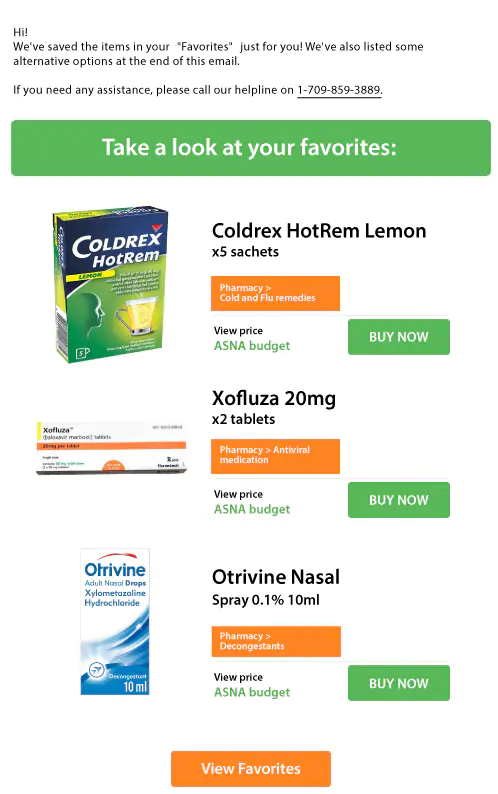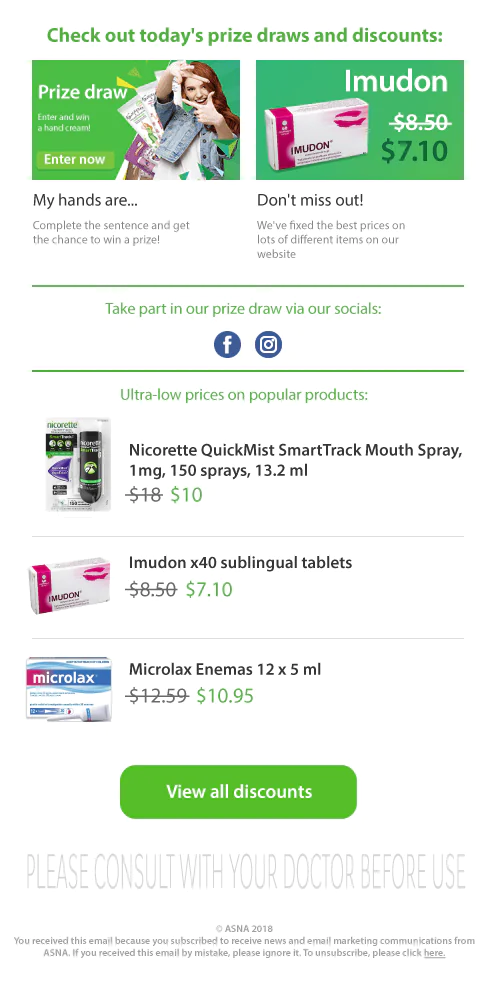ASNA Pharmacies’ Story: 10% Growth of Direct Channel Revenue Shares
ASNA Pharmacies’ Story: 10% Growth of Direct Channel Revenue Shares
ASNA is a large company that unites more than 8,500 pharmacies across Eastern Europe, remaining a top-ranking pharmacy chain since 2015. The company’s partners are present in more than 100 cities.
Customers place an order on the ASNA website after registering with their cell phone number, and pay for the order at the selected pharmacy during pickup. Thanks to this mechanism, ASNA has a large base of subscribers with cell phones. Some customers also provide their email address to receive additional communications.
The company’s management aimed to generate additional revenue by leveraging their subscriber base. To reach this goal, Maestra combined the efforts of its market analysts with Anton Kovylkin, a marketing specialist at ASNA.
Together we identified three main goals:
- Launching automatic campaigns and improving them through A/B testing
- Automating manual communications
- Converting the cell phone database into an email database to reduce the cost of using the relatively expensive SMS channel.
Results
We began work in 2018 and, within six months, increased the share of email revenue to 10% for customers who provided their email addresses.
Here’s how we did it:
Share of revenue by email channel (only for customers who provided their email addresses)

Maestra really helped us make a big step towards marketing personalization and automation, and we have continued developing in this direction since we integrated the platform.
Along with experts from Maestra, we managed to build a well-thought-out plan for customer communication. We help our customers decide which products to buy using personalized recommendations, taking into account their browsing and purchase history, as well as interactions with campaigns. All this is due to the fact that we now collect and store customer information in one place. We have the opportunity to communicate with them much more precisely and efficiently.
We started sending personalized text messages and emails in small segments. There is no need to send campaigns manually as half of them are now sent by the system automatically.
Now, we are planning to test campaigns with promo codes and ultra-personalized promotions for partner brands. There are a lot of launches of new projects and improvements on current ones ahead. We have big expectations and future plans to work with the Maestra system.
In total, we launched 11 automated email campaigns
At the start of the project in May, ASNA sent only one-off manual email campaigns and service emails on order statuses. Working together with Anton, the Maestra team proposed the launch of 15 automated workflows that covered the entire life cycle of ASNA customers.
Segment
Goal
Workflow
Beginners
First purchase
Welcome-chain
Registered but did not make a purchase for one month
Active
Repeat purchases
Abandoned cart
Abandoned product browse
Abandoned category browse
There are three or more products in Favorites
Repeatedly abandoned session
NPS survey after successful order
Abandoned product browse
Abandoned category browse
There are three or more products in Favorites
Repeatedly abandoned session
NPS survey after successful order
Churn
Reactivation, return to shopping
Recommendations for inactive customers
Seasonal (summer and fall) campaigns
Seasonal (summer and fall) campaigns
Other
Get an estimate
Campaign — Get $3 for a review (SMS)
A list of campaigns launched
When automating campaigns, we decided to move iteratively, starting with the launch of standard Maestra workflows — abandoned cart, abandoned product browses, and abandoned category browses.
As expected, the largest order conversion rate, 4.2%, was demonstrated by the automated abandoned cart campaign.

An example of the abandoned cart email
We then proceeded with the launch of specific campaigns that correspond to the particulars of the business, such as the examples outlined below.
Products in favorites
Customers add the products they like to their favorites list on the ASNA website. We can assume that consumers add products to this list to think twice before they are actually ready to buy them.
Our hypothesis was to remind the user about the products in the favorites at a certain moment (when there are 3 or more of them) and offer an alternative — after all, the customer is still considering whether to buy them or not. In the email, we provide recommendations for generic medicine proposed by Maestra based on the selected positions. The order conversion rate was 3.3%.


An example of an email from the “There are three or more products in Favorites” campaign
Seasonal campaigns with useful tips
The use of some medicine is closely aligned with seasonal activity, so we launched seasonal campaigns to correspond with this. In fall and winter, people catch colds more often; in spring and summer, they suffer from allergies. Interesting informational content is regularly published on ASNA’s social networks, so we leveraged this as a focal point of the emails. For the summer period, we prepared a campaign with tips on how to cope with allergies on vacation, and for the fall, we came up with recommendations for fighting colds and the flu.
To continually grow and improve, we set up regular A/B testing. For example, the email theme was tested in the fall seasonal offer, and option A won with a 99% confidence rate (according to the open rate).
Option A: Fall without a cold!
Option B: How not to get sick this fall?

The result of the test was calculated using Maestra’s A/B test calculator
Automated SMS feedback requests
The NPS survey holds the top spot of Maestra’s standard workflows. We launched the automated email with an NPS survey right after we sorted out the abandoned cart and category workflows. The purpose of the email is to collect feedback from customers who evaluate their order on a 10-point scale. The customers are also asked to leave a review on Yandex.Market, an external platform that customers often look to before they make a purchase.
We randomly selected a certain number of customers out of those who made an order within the previous two days and asked these customers to leave a review on Yandex.Market. Maestra automated this process, replacing the daily manual work of ASNA’s marketer.

Text message requesting to leave feedback
Email subscriptions from customers with phone numbers
When making a purchase with ASNA, the customer leaves their phone number. Providing an email address is optional, so this field is seldom filled in. In the company’s database, 88% of customers provided no email address.
To work with the database as efficiently as possible, we decided to add email addresses to this category and started a reactivation campaign. During the first stage, we decided not to introduce a stimulating reward but simply talk about the benefits of shopping at ASNA.
The campaign included several stages:
- The customer received a text message with an invitation to leave their email address.
- The link from the text message led to a landing page with a field for entering an email address.
- If the customer subscribed, they received a welcome email series.
The result was compared with a customer from the control group who didn’t receive a text message.
- For the entire group that received a text message, the conversion rate was 0,63% (with slight differences between segments).
- For the control group, the conversion rate amounted to 0,025%.
The difference in conversion is significant, which means the campaign really brought in new subscribers and was ultimately a success.


Landing page for collecting customer emails. Customers access it by following the link from the text message

An email is sent to subscribers after entering their email address on the landing page
During the test stage, we thought about the cost of attracting one email and considered ways to reduce it.
We identified three areas to be optimized:
- The test was conducted on a small base of 15,000 people to minimize losses if the campaign was unsuccessful.
- We divided customers into segments based on their activity:
— Registered on the website but never made a purchase;
— Placed at least one order but more than 90 days ago;
— Placed at least one order recently (from 5 to 90 days ago).
— Placed at least one order but more than 90 days ago;
— Placed at least one order recently (from 5 to 90 days ago).
The same amount of money was spent on sending text messages in each segment. If the responses would turn out to be different, it would mean the segments had a different cost of attracting one email address. In the future, this will help to exclude high-cost segments from the campaign.
3. We tested the text message length using two versions of the text: long and short.


Text message options for the A/B test: long and short text
The results differ significantly between segments and text message length with a 95% reliability score:
Segment
Text message length
Number of recipients
Click rate, %
% of customers who left an email address
The cost of obtaining one email
Never made a purchase
short
long
long
2,458
2,456
2,456
2,2%
1.6%
1.6%
0,2%
0.4%
0.4%
$10
$13
$13
Made a purchase a long time ago
short
long
long
2,455
2,475
2,475
3,0%
2.1%
2.1%
0,5%
0.3%
0.3%
$4.6
$15.5
$15.5
Made a
short
2,485
5.4%
1.5%
$1.6
Made a purchase recently
long
2,451
3,3%
0,8%
$6
Comparison of SMS campaign options by segment
The cost of attracting 1 email by segment varies from $1.6 to $15.5. Ultimately, the automatic SMS campaign was kept only for the most profitable segment: customers who made a purchase recently and received a short text message.
Conclusions and future plans
The work done on these campaigns increased overall revenue share from the email channel to 10%, so future CRM development plans include:
- Launching more campaigns (e.g., reminders about regular medicine, notifications about the new pharmacies in customer areas)
- Adding promo codes to emails and text messages
- Continuing tests on converting phone numbers to email addresses, which includes adding promo codes
- Carrying out experiments with new types of content in campaigns, including contests, articles, etc.
- Testing cross-promotions with medicine manufacturers.

